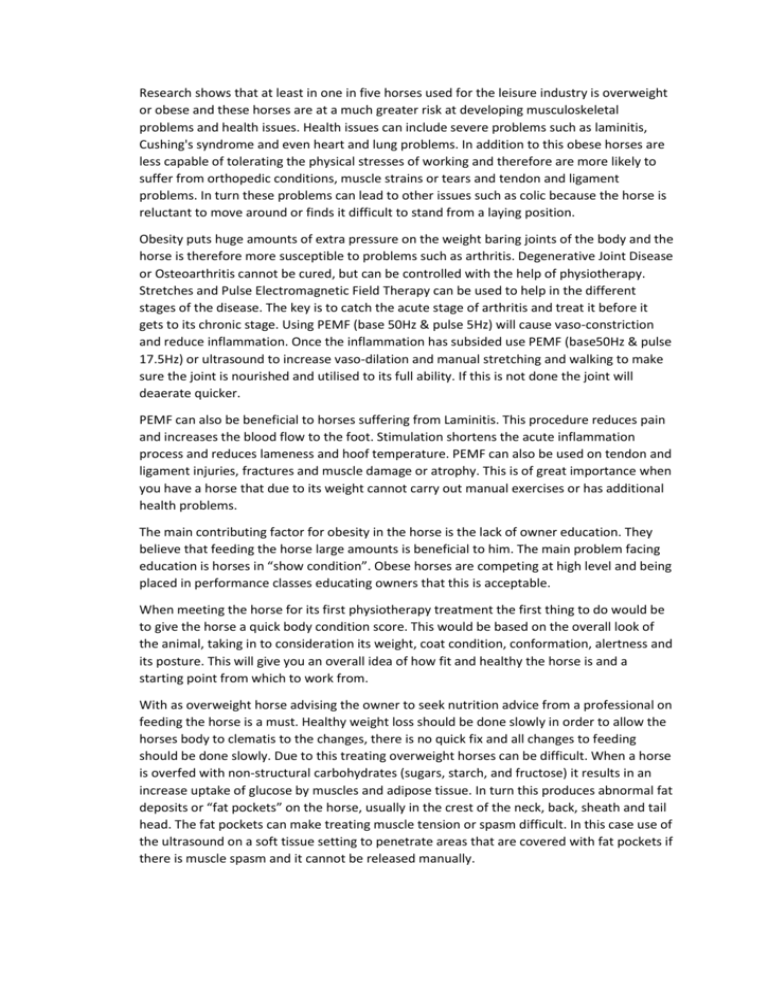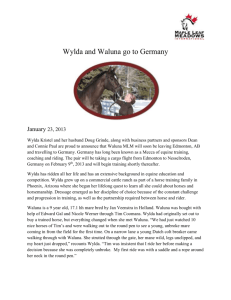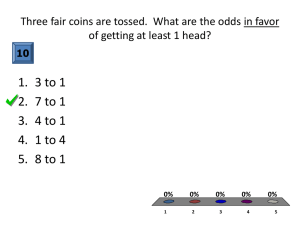Further information about equine obesity and its implications during
advertisement

Research shows that at least in one in five horses used for the leisure industry is overweight or obese and these horses are at a much greater risk at developing musculoskeletal problems and health issues. Health issues can include severe problems such as laminitis, Cushing's syndrome and even heart and lung problems. In addition to this obese horses are less capable of tolerating the physical stresses of working and therefore are more likely to suffer from orthopedic conditions, muscle strains or tears and tendon and ligament problems. In turn these problems can lead to other issues such as colic because the horse is reluctant to move around or finds it difficult to stand from a laying position. Obesity puts huge amounts of extra pressure on the weight baring joints of the body and the horse is therefore more susceptible to problems such as arthritis. Degenerative Joint Disease or Osteoarthritis cannot be cured, but can be controlled with the help of physiotherapy. Stretches and Pulse Electromagnetic Field Therapy can be used to help in the different stages of the disease. The key is to catch the acute stage of arthritis and treat it before it gets to its chronic stage. Using PEMF (base 50Hz & pulse 5Hz) will cause vaso-constriction and reduce inflammation. Once the inflammation has subsided use PEMF (base50Hz & pulse 17.5Hz) or ultrasound to increase vaso-dilation and manual stretching and walking to make sure the joint is nourished and utilised to its full ability. If this is not done the joint will deaerate quicker. PEMF can also be beneficial to horses suffering from Laminitis. This procedure reduces pain and increases the blood flow to the foot. Stimulation shortens the acute inflammation process and reduces lameness and hoof temperature. PEMF can also be used on tendon and ligament injuries, fractures and muscle damage or atrophy. This is of great importance when you have a horse that due to its weight cannot carry out manual exercises or has additional health problems. The main contributing factor for obesity in the horse is the lack of owner education. They believe that feeding the horse large amounts is beneficial to him. The main problem facing education is horses in “show condition”. Obese horses are competing at high level and being placed in performance classes educating owners that this is acceptable. When meeting the horse for its first physiotherapy treatment the first thing to do would be to give the horse a quick body condition score. This would be based on the overall look of the animal, taking in to consideration its weight, coat condition, conformation, alertness and its posture. This will give you an overall idea of how fit and healthy the horse is and a starting point from which to work from. With as overweight horse advising the owner to seek nutrition advice from a professional on feeding the horse is a must. Healthy weight loss should be done slowly in order to allow the horses body to clematis to the changes, there is no quick fix and all changes to feeding should be done slowly. Due to this treating overweight horses can be difficult. When a horse is overfed with non-structural carbohydrates (sugars, starch, and fructose) it results in an increase uptake of glucose by muscles and adipose tissue. In turn this produces abnormal fat deposits or “fat pockets” on the horse, usually in the crest of the neck, back, sheath and tail head. The fat pockets can make treating muscle tension or spasm difficult. In this case use of the ultrasound on a soft tissue setting to penetrate areas that are covered with fat pockets if there is muscle spasm and it cannot be released manually. Advising the owner to have the saddle checked is also a good idea. In some cases the saddle will have been fitted when the horse was leaner and therefore with the increase in weight the saddle may now be too tight and be causing muscular problems. Figure 1. Clearly showing the different body conditions of horses along with the condition score. As a physiotherapist treating an overweight/ obese horse it is important to modify treatments that this particular horse is able to cope with. Due to the extra weight of the horse recovery of injury it can take a lot longer and can be a lot slower process because of the strain that is put on the injury with standing alone. There can also be an increased risk of further injuries or complications as the horse compensates for the difficulty of exercises. All these factors increase the need for physiotherapy even more. Other considerations can be that the adipokines (substances produced by fat) affect inflammation and homeostasis (the internal control of CO2, urea, sugars, water, ions and temperature), which can have a huge effect on recovery times. When using exercise to treat an obese horse it is very important the exercise is controlled and limited. Control throughout the exercises will limit the chance of further injuries as the horse has to use itself correctly. Ideally an obese horse suffering an injury should not be ridden as the weight of the rider will only add further pressure to the injury or compensating muscles. There are a number of ways in which exercise can be controlled for an overweight horse and one of the best is a water treadmill. This allows the work time and intensity to be monitored closely but also creates slight resistance to a low intensity level exercise such as walking. Many physiotherapists like to use swimming pools for the same reason, however in my opinion they encourage the horse to hollow its back and raise its head up out of the water when ideally we want the horse to lower its head and round the back therefore I would not recommend this. These methods are not readily available therefore in most cases other treatments need to be found. Horse walkers or walking the horse in hand (depending on the injury) are useful tools to begin to aid the weight loss. This is a low intensity exercise for the limbs and joints that will burn calories. The use of poles within the rehabilitation program will encourage the horse to work harder and flex the joints more when walking around, again burning calories using low intensity, low concussion methods. Once the weight loss is at a point it is safe to increase the intensity of the work, exercises must be increased slowly allowing for the injury/ condition to take further priority. It will be common to see large amounts of muscle atrophy when the fat has gone, therefore it is important at this stage to work on muscle strengthening exercises. Due to the limitations when working with an obese horse it is very useful to have the correct machinery to assist with the problems and healing process. Key machines such as Ultrasound and PEMF can not only kick start the healing process, limit other issues allowing you to concentrate on the injury and can continue to assist the healing as the exercise program is put in place and carried out.







